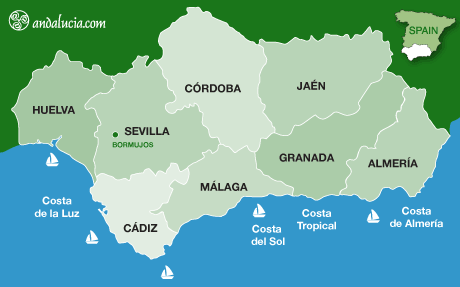BORMUJOS
by Saskia Mier
Bormujos is an agricultural suburban town of Seville, inhabited by many who look to live outside the city but close enough to commute to the centre for work. It has about 21,400 inhabitants.
HISTORY
The first settlements in Bormujos date to the Roman era, although it is supposed that a settlement already existed in the Aljarafe area before this. Originally produced olives for oil, these towns became alquerías (farms) during the Islamic era.
According to writer, García de Diego, the name comes from the Latin word "Mormolium", but also likely to come from the name given to a Muslim farmhouse "Boromuji". Moorish vestiges are can still be seen in the area, particularly, Hacienda de Valencilla.
In the Repartimiento of Seville by Alfonso X, Bormujos appeared under the name Mormojos or Mormujos. In 1253, the Rey Sabio granted it, together with many other farms in Mairena, Paterna, Alcaudín, Malharomata and Albarat, to two hundred horsemen for the good service to his father, Fernando III in the conquest of Andalusia and especially in the seizure of Seville.
Bormujos depended on the Town Hall of Seville, belonging to the Vicariate of Seville, owned by the Lordship of, Don Luis de Araoz y Montalvo. In 1630, Bormujos along with El Garrobo, Gerena and Burguillos were sold for 500,000 ducats to the Lords of Juan Bautista Sixmán, Pedro de Torquemada and Doña Rufina de Sandoval. Later, Seville regained jurisdiction of these towns.
At the end of the seventeenth or early eighteenth century, Bormujos passed into the hands of the Guzmán family, until the disappearance of the Señoríos. Since then, it has become independent.
Hotels
Book hotels in Bormujos
THINGS TO SEE
Iglesia de la Encarnación
The church dates to the late Middle Ages, reformed between 1678 and 1681 by, Antonio Rodríguez and Francisco Romero. The main front and left side were decorated between 1778 and 1779 by, Pedro de Silva. Located in Plaza la Iglesia.
Convento de Santa María la Real
A Dominican convent built in 1976, with numerous ancient pieces from Santa María de Gracia, Santa María de los Reyes and Santa María la Real. Located on Avenida Bormujos.
Hacienda de Belén
The alquería (farmhouse) is said to be the beginning of the settlement of Bormujos and its main house still preserves part of the oil mill, winery and wine cellar. Currently the Hacienda de Belén is being restored by the Town Hall of Bormujos and is municipal property. Located in Calle Monte Sierras.
Hacienda La Peregrina
The Hacienda houses an oil mill with a tower and wine cellars. It is of private property, and the first hydraulic press was installed in the mill in 1928 that was shown the following year in the Ibero-American Exhibition of Seville. Located on Avenida Pdte. Adolfo Suarez.
THINGS TO SEE OUTSIDE THE VILLAGE
Hacienda de Marchalomar
The Hacienda consists of a garden, front orchard, stables, mill, ferris wheel, pool, cottages, barn and chicken yard. It is of private property. Located north west of Bormujos.
Hacienda de Valencinilla del Hoyo
The Hacienda has beautiful gardens and a lookout tower with views over the valley of the River Pudio. It is privately owned. Located next to the Cañada Real.
GASTRONOMY
Bormujos offers traditional dishes such as cocido de codillo (pork stew), cocido de carne de caza (game stew), arroz con carne de caza (rice made with game such as wild birds or rabbit), caracoles (snails), caldereta (stew), calabacines rebozados (breadcrumbed courgettes), salmorejo (cold tomato soup), menudo (offal), arroces marineros (seafood rice), espinacas con tomate (asparagus with tomato), carne a la brasa (grilled meat), berenjenas rellenas (stuffed aubergines), potaje de garbanzos (chickpea stew), cocido de habas y guisantes (pea and broad bean stew). Sweet treats include tortas (sponges), dulces del Convent of Santa Maria la Real (sweets made by nuns in the Convent), torrijas (eggy bread) and tiramisús de caramelo y chocolate (chocolate and caramel tiramisu). It is worth trying the vino de naranja (orange wine), mosto (grape juice) and mosto achampanado (sparkling grape juice), which are all very well known in Bormujos.
FESTIVALS
Cabalgata Reyes Magos
Three Kings procession celebrated on the evening of 5 January.
Carnaval
Celebrated in February.
Día de Andalucía
Celebrated the 28 February.
Semana Santa
Holy Week.
Fiestas de Cruz
Celebrated in May.
Velá de Santiago y Santa Ana
Celebrated the last week of July.
Feria
Celebrated at the end of August.
Fiestividad del Patrón Santo Domingo de Silos
Celebrated on the 20 December.
NEXT PLACES
The next villages to Bormujos are Tomares, Gines, Mairena del Aljarafe and Bollullos de la Mitación.

